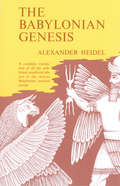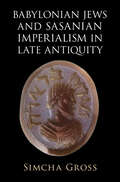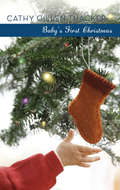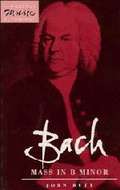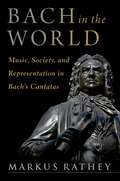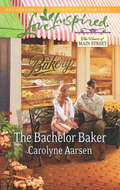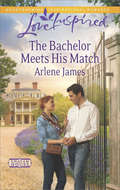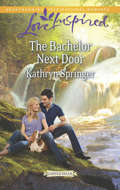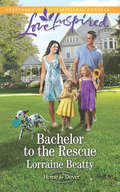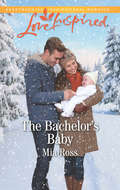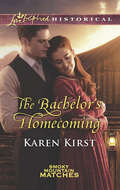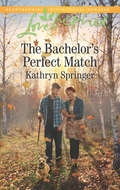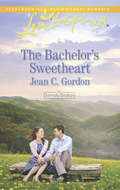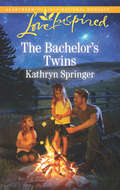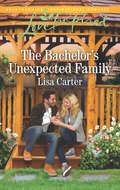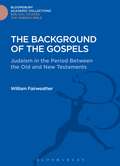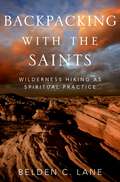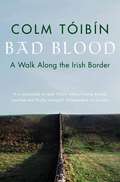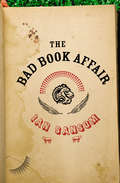- Table View
- List View
The Babylonian Genesis: The Story of the Creation
by Alexander HeidelHere is a complete translation of all the published cuneiform tablets of the various Babylonian creation stories, of both the Semitic Babylonian and the Sumerian material. Each creation account is preceded by a brief introduction dealing with the age and provenance of the tablets, the aim and purpose of the story, etc. Also included is a translation and discussion of two Babylonian creation versions written in Greek. The final chapter presents a detailed examination of the Babylonian creation accounts in their relation to our Old Testament literature.
Babylonian Jews and Sasanian Imperialism in Late Antiquity
by null Simcha GrossFrom the image offered by the Babylonian Talmud, Jewish elites were deeply embedded within the Sasanian Empire (224-651 CE). The Talmud is replete with stories and discussions that feature Sasanian kings, Zoroastrian magi, fire temples, imperial administrators, Sasanian laws, Persian customs, and more quotidian details of Jewish life. Yet, in the scholarly literature on the Babylonian Talmud and the Jews of Babylonia , the Sasanian Empire has served as a backdrop to a decidedly parochial Jewish story, having little if any direct impact on Babylonian Jewish life and especially the rabbis. Babylonian Jews and Sasanian Imperialism in Late Antiquity advances a radically different understanding of Babylonian Jewish history and Sasanian rule. Building upon recent scholarship, Simcha Gross portrays a more immanent model of Sasanian rule, within and against which Jews invariably positioned and defined themselves. Babylonian Jews realized their traditions, teachings, and social position within the political, social, religious, and cultural conditions generated by Sasanian rule.
Baby's First Christmas (Mills And Boon Silhouette Ser.)
by Cathy Gillen ThackerA 7 lb. 8 oz. Christmas Package!
Bach: Mass In B Minor (PDF)
by John ButtThe Mass in B Minor is arguably Bach's greatest single work. In this short guide John Butt considers the work from many angles offering the reader basic information in a concise and accessible form. The Mass in B Minor is fraught with difficulties regarding its origin, and ambiguities concerning its function. John Butt looks again at the historical sources and provides an up-to-date summary of existing research and opinions together with new insights of his own. He gives a vivid account of the work's genesis, its historical context, and its reception by later generations. One chapter considers the work movement by movement providing the text in both Latin and English. The final group of chapters on the music itself suggests some new approaches to the work - its forms, style and overall structure - which are both critically and historically based. This is an informative and lucid guide, valuable for student and music lover alike. 9780521387163
Bach in the World: Music, Society, and Representation in Bach's Cantatas
by Markus RatheyJohann Sebastian Bach's works are often classified as either sacred or secular. While this distinction is fraught, it seems to provide a useful way to distinguish between Bach's vocal works for the liturgy and those he wrote to honor courts and members of the nobility. But even so, the lines cannot be drawn clearly. The political and social systems of the time relied on religion as an ideological foundation, and public displays of political power almost always included religious rituals and thus required some form of sacred music. Social constructs, such as class and gender, were also embedded in religious frameworks. In Bach in the World, author Markus Rathey offers a new exploration of how Bach's music functioned as an agent of affective communication within rituals, such as the installation of the town council, and as a place where socio-political norms were perpetuated and sometimes even challenged. The book does so by analyzing public manifestations of the social order during Bach's time in large-scale celebrations, processions, public performances, and visual displays.
Bach in the World: Music, Society, and Representation in Bach's Cantatas
by Markus RatheyJohann Sebastian Bach's works are often classified as either sacred or secular. While this distinction is fraught, it seems to provide a useful way to distinguish between Bach's vocal works for the liturgy and those he wrote to honor courts and members of the nobility. But even so, the lines cannot be drawn clearly. The political and social systems of the time relied on religion as an ideological foundation, and public displays of political power almost always included religious rituals and thus required some form of sacred music. Social constructs, such as class and gender, were also embedded in religious frameworks. In Bach in the World, author Markus Rathey offers a new exploration of how Bach's music functioned as an agent of affective communication within rituals, such as the installation of the town council, and as a place where socio-political norms were perpetuated and sometimes even challenged. The book does so by analyzing public manifestations of the social order during Bach's time in large-scale celebrations, processions, public performances, and visual displays.
The Bachelor Baker (The Heart of Main Street #2)
by Carolyne AarsenAn anonymous benefactor brought Melissa Sweeney to the once-booming town of Bygones, Kansas. But she can’t fulfill her longtime dream of starting up her own bakery without help.
The Bachelor Meets His Match: Single Dad Cowboy The Bachelor Meets His Match Unexpected Reunion (Chatam House #8)
by Arlene JamesA Lesson In Love
The Bachelor Next Door: The Bachelor Next Door Small-town Homecoming Their Unexpected Love (Castle Falls #1)
by Kathryn SpringerTime for Love
Bachelor to the Rescue: The Rancher Takes A Bride The Single Dad Finds A Wife Bachelor To The Rescue (Home to Dover #5)
by Lorraine BeattyBuilding a Romance
The Bachelor's Baby: A Cowboy For The Twins Her Secret Daughter The Bachelor's Baby (Liberty Creek #2)
by Mia RossForging a Family
The Bachelor's Homecoming: A Baby For Christmas The Rancher's Christmas Proposal The Bachelor's Homecoming The Mistletoe Kiss (Smoky Mountain Matches #7)
by Karen KirstSuddenly Reunited
The Bachelor's Perfect Match: Anna's Forgotten Fiance The Bachelor's Perfect Match Reunited By A Secret Child (Castle Falls #3)
by Kathryn SpringerHe loves adventures… She only reads them…until now!
The Bachelor's Sweetheart: The Texan's Second Chance The Bachelor's Sweetheart Lakeside Romance (The Donnelly Brothers #3)
by Jean C. GordonFalling for the Bachelor
The Bachelor's Unexpected Family (Mills And Boon Love Inspired Ser.)
by Lisa CarterSecond Chance Family
Bachzitate: Übergänge zwischen Klang und Bild im Anschluss an Bach (rerum religionum. Arbeiten zur Religionskultur #9)
by Klaus Hock Thomas KlieWelche Wirkungen hat die Musik Johann Sebastian Bachs im Interferenzfeld von Bild und Klang hervorgerufen? Wie haben sich innovative, kreative, phantasievolle, gelegentlich auch irritierende und verstörende klangfarbliche oder farbklangliche Neukompositionen von dem großen Kirchenmusiker inspirieren lassen? Die Beiträger*innen des Bandes befassen sich aus verschiedenen disziplinären Perspektiven mit dem Verhältnis von Bildlichem und Klanglichem in der Rezeption des Bach'schen Werkes und der Musiktraditionen des Barock. Über das Visuelle und Akustische hinaus kommen dabei auch Dimensionen des Synästhetischen und Performativen zur Sprache.
Back-Pocket God: Religion and Spirituality in the Lives of Emerging Adults
by Melinda Lundquist Denton Richard FloryMore than a decade ago, a group of researchers began to study the religious and spiritual lives of American teenagers. They tracked these young people over the course of a decade, revisiting them periodically to check in on the state -and future- of religion in America, and reporting on their findings in a series of books, beginning with Soul Searching (2005). Now, with Back-Pocket God, this mammoth research project comes to its conclusion. What have we learned about the changing shape of religion in America? Back-Pocket God explores continuity and change among young people from their teenage years through the latter stages of "emerging adulthood." Melinda Lundquist Denton and Richard Flory find that the story of young adult religion is one of an overall decline in commitment and affiliation, and in general, a moving away from organized religion. Yet, there is also a parallel trend in which a small, religiously committed group of emerging adults claim faith as an important fixture in their lives. Emerging adults don't seem so much opposed to religion or to religious organizations, at least in the abstract, as they are uninterested in religion, at least as they have experienced it. Religion is like an app on the ubiquitous smartphones in our back pockets: readily accessible, easy to control, and useful-but only for limited purposes. Denton and Flory show that some of the popular assumptions about young people and religion are not as clear as what many people seem to believe. The authors challenge the characterizations of religiously unaffiliated emerging adults -sometimes called "religious nones"- as undercover atheists. At the other end of the spectrum, they question the assumption that those who are not religious will return to religion once they marry and have children.
Back-Pocket God: Religion and Spirituality in the Lives of Emerging Adults
by Richard Flory Melinda Lundquist DentonMore than a decade ago, a group of researchers began to study the religious and spiritual lives of American teenagers. They tracked these young people over the course of a decade, revisiting them periodically to check in on the state -and future- of religion in America, and reporting on their findings in a series of books, beginning with Soul Searching (2005). Now, with Back-Pocket God, this mammoth research project comes to its conclusion. What have we learned about the changing shape of religion in America? Back-Pocket God explores continuity and change among young people from their teenage years through the latter stages of "emerging adulthood." Melinda Lundquist Denton and Richard Flory find that the story of young adult religion is one of an overall decline in commitment and affiliation, and in general, a moving away from organized religion. Yet, there is also a parallel trend in which a small, religiously committed group of emerging adults claim faith as an important fixture in their lives. Emerging adults don't seem so much opposed to religion or to religious organizations, at least in the abstract, as they are uninterested in religion, at least as they have experienced it. Religion is like an app on the ubiquitous smartphones in our back pockets: readily accessible, easy to control, and useful-but only for limited purposes. Denton and Flory show that some of the popular assumptions about young people and religion are not as clear as what many people seem to believe. The authors challenge the characterizations of religiously unaffiliated emerging adults -sometimes called "religious nones"- as undercover atheists. At the other end of the spectrum, they question the assumption that those who are not religious will return to religion once they marry and have children.
The Background of the Gospels: Judaism in the Period between the Old and New Testaments (Bloomsbury Academic Collections: Biblical Studies)
by William FairweatherCovering the period from the Maccabean revolt to the destruction of Jerusalem under Titus, Fairweather's impressive work should be an important point of reference for those wanting to develop their knowledge on the evolution of Judaism as a spiritual movement.
Backpacking with the Saints: Wilderness Hiking as Spiritual Practice
by Belden C. LaneCarrying only basic camping equipment and a collection of the world's great spiritual writings, Belden C. Lane embarks on solitary spiritual treks through the Ozarks and across the American Southwest. For companions, he has only such teachers as Rumi, John of the Cross, Hildegard of Bingen, Dag Hammarskjöld, and Thomas Merton, and as he walks, he engages their writings with the natural wonders he encounters--Bell Mountain Wilderness with Søren Kierkegaard, Moonshine Hollow with Thich Nhat Hanh--demonstrating how being alone in the wild opens a rare view onto one's interior landscape, and how the saints' writings reveal the divine in nature. The discipline of backpacking, Lane shows, is a metaphor for a spiritual journey. Just as the wilderness offered revelations to the early Desert Christians, backpacking hones crucial spiritual skills: paying attention, traveling light, practicing silence, and exercising wonder. Lane engages the practice not only with a wide range of spiritual writings--Celtic, Catholic, Protestant, Buddhist, Hindu, and Sufi Muslim--but with the fascination of other lovers of the backcountry, from John Muir and Ed Abbey to Bill Plotkin and Cheryl Strayed. In this intimate and down-to-earth narrative, backpacking is shown to be a spiritual practice that allows the discovery of God amidst the beauty and unexpected terrors of nature. Adoration, Lane suggests, is the most appropriate human response to what we cannot explain, but have nonetheless learned to love. An enchanting narrative for Christians of all denominations, Backpacking with the Saints is an inspiring exploration of how solitude, simplicity, and mindfulness are illuminated and encouraged by the discipline of backcountry wandering, and of how the wilderness itself becomes a way of knowing-an ecology of the soul.
Backpacking with the Saints: Wilderness Hiking as Spiritual Practice
by Belden C. LaneCarrying only basic camping equipment and a collection of the world's great spiritual writings, Belden C. Lane embarks on solitary spiritual treks through the Ozarks and across the American Southwest. For companions, he has only such teachers as Rumi, John of the Cross, Hildegard of Bingen, Dag Hammarskjöld, and Thomas Merton, and as he walks, he engages their writings with the natural wonders he encounters--Bell Mountain Wilderness with Søren Kierkegaard, Moonshine Hollow with Thich Nhat Hanh--demonstrating how being alone in the wild opens a rare view onto one's interior landscape, and how the saints' writings reveal the divine in nature. The discipline of backpacking, Lane shows, is a metaphor for a spiritual journey. Just as the wilderness offered revelations to the early Desert Christians, backpacking hones crucial spiritual skills: paying attention, traveling light, practicing silence, and exercising wonder. Lane engages the practice not only with a wide range of spiritual writings--Celtic, Catholic, Protestant, Buddhist, Hindu, and Sufi Muslim--but with the fascination of other lovers of the backcountry, from John Muir and Ed Abbey to Bill Plotkin and Cheryl Strayed. In this intimate and down-to-earth narrative, backpacking is shown to be a spiritual practice that allows the discovery of God amidst the beauty and unexpected terrors of nature. Adoration, Lane suggests, is the most appropriate human response to what we cannot explain, but have nonetheless learned to love. An enchanting narrative for Christians of all denominations, Backpacking with the Saints is an inspiring exploration of how solitude, simplicity, and mindfulness are illuminated and encouraged by the discipline of backcountry wandering, and of how the wilderness itself becomes a way of knowing-an ecology of the soul.
Bad Blood
by Colm TóibínIn the summer after the Anglo-Irish Agreement, when tension was high in Northern Ireland, Colm Tóibín walked along the border from Derry to Newry. Bad Blood is a stark and evocative account of this journey through fear and hatred, and a report on ordinary life and the legacy of history in a bleak and desolate landscape.Tóibín describes the rituals – the marches, the funerals, the demonstrations – observed by both communities along the border, and listens to the stories which haunt both sides. With sympathy and insight Bad Blood captures the intimacy of life along one of the most contested strips of land in Western Europe.
The Bad Book Affair: A Mobile Library Mystery (The\mobile Library Mystery Ser. #4)
by Ian SansomThe Bad Book Affair features the magnificently hapless Israel Armstrong – the duffle-coat wearing, navel-gazing Jewish librarian who solves crimes, mysteries, and domestic problems whilst driving a mobile library around the north coast of Ireland.
